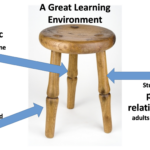How Do You Promote Intrinsic Motivation at School When Kids Get Extrinsic Motivators at Home?
A teacher recently wrote me an email asking for some advice about student motivation. She graciously agreed to let my answer morph into a blog post.
I just finished listening to your ASCD webinar about language. I found your presentation thoughtful, informative, and practical.
My question for you is, how do you think a teacher (or school) can help facilitate intrinsic motivation when the students are being sent very different messages at home? It is very evident through student and parent anecdotes, that negotiation and bribery are common practices at home.
I am witnessing student motivation decrease, and I would love suggestions on how to combat this problem effectively.
Ashley Waggener, Alexandria, VA
This is a question I hear a lot as I work in schools around the United States. I also had this issue in my own teaching. It was common for parents in the schools in which I taught to use extrinsic motivators. (I remember one father getting really upset at a PTO meeting when he realized he owed his kid over $200 for the latest report card. We had just switched from traditional grades to standards-based ones, and there were a lot more categories!)
It can be challenging when students are getting different messages about why they should be motivated about schoolwork at home and school. Here are a few ideas to consider.
Limit Homework
Things get complicated when the worlds of schoolwork and homework overlap. That’s when you get kids being bribed to read or work on projects (which often leads to power struggles and demotivation). This can undo the intrinsic motivation we’re trying to cook into work and lead kids to stop working or to do the bare minimum. Instead, let’s keep work at school. If parents want to use extrinsic motivators to get their kids to take out the trash and clean their rooms, at least it won’t have a direct impact on their learning.
Teach Students to Code-Switch
Code-switching is when you behave differently in different settings or situations. I used to talk with my fifth graders about this all of the time. I’d tell them, if you and your friends like to swear when you’re hanging out together–let ’em rip. But when we’re at morning meeting, or you’re having a writing conference, or you’re on the school playground where some kids (and most adults) don’t want to hear swearing, then you’ve got to hold back. So, after you’ve told the class it’s time to clean up base-ten blocks from math and line up for art class, if a kid says, “My mom pays me $5 to clean up,” you can respond, “Yep. There are different systems at school and home. It’s time to clean up.”
Bake Intrinsic Motivation Into Activities, Lessons, and Units
Remember the five intrinsic motivators I shared in the webinar (autonomy, purpose, mastery, belonging, and fun)? Make sure at least one (hopefully more) is present in whatever kids are doing. For example, if you’re all working on multiplying fractions, you might…
- give students choices about practice sheets or individual problems to solve (autonomy, mastery)
- have students create a class bulletin board to highlight their learning (purpose, belonging, mastery)
- have kids create (and then play) games to practice multiplying fractions (fun, mastery, purpose, autonomy, belonging)
When the work itself has intrinsic motivators present, there’s no longer a need to rely on stickers, food, prizes, or grades to motivate behavior.
Watch Out for Demotivators
Sometimes, we accidentally use practices in school that have the reverse of the intended effect. For example…
- Data walls that publicly post which students have mastered key skills or competencies are meant to inspire students, but (especially for struggling students) they can raise anxiety and cause humiliation.
- Another common example is certain kinds of praise. When teachers praise students’ intelligence (“You’re so smart!”), students may experience anxiety, causing them to take fewer learning risks. When teachers use teacher-pleasing praise (“I love how hard you’re working!”), students might worry so much about making their teacher happy that they make learning decisions based on what they think their teacher wants instead of what they actually need as a learner. (Instead, teachers can praise what students are doing: “Wow! Look at the progress you’re making! You’re really learning how to multiply fractions!”)
- And, of course, resist the urge to use extrinsic motivators when kids are struggling with motivation. Instead, have kids lend a hand in thinking of ways to make the work more meaningful, fun, etc. When you cave and use stickers/candy/grades/etc. to motivate in the moment, you erode long-term intrinsic motivation.
Focus on Long-Term Gains, Not Short-Term Ones
Stickers, pizza parties, gems in jars, and other extrinsic motivators are seductive because they appear to “work” in the moment. They often elicit a gasp of excitement and a burst of focus and energy from students. Be careful though. Like a caffeine and sugar high that quickly fades after you guzzle a Coke, student enthusiasm rapidly erodes, leaving kids less motivated in the long run. Motivational gimmicks also don’t teach skills. Kids who struggle with self-control or academics need practical strategies to support success.





Comments
I love this idea of “code-switch.” This is so important to teach. We talk about this a lot when we write for a particular audience, so why not make the same connection to the way we behave in certain situations. AND…yes! Can we continue to talk about limiting homework and remind families to use that time for sitting down to dinner, and simply interacting with one another? After cutting down on homework the last couple of years, I have found I am significantly less stressed about chasing students for math worksheets. In turn, they are less stressed, I’m sure!